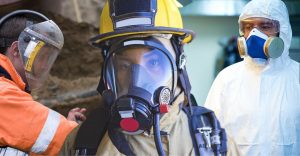 Occupational Safety and Health (OSH) in India is an area of growing importance due to the rapid industrialization, expanding workforce, and increasing awareness of workplace safety. Ensuring safe and healthy work environments has become a key concern for both the government and industries, given the country’s diverse and high-risk sectors such as construction, manufacturing, mining, and chemicals. However, challenges remain in fully implementing robust safety measures, especially in the informal sector, which constitutes a significant portion of India’s workforce.
Occupational Safety and Health (OSH) in India is an area of growing importance due to the rapid industrialization, expanding workforce, and increasing awareness of workplace safety. Ensuring safe and healthy work environments has become a key concern for both the government and industries, given the country’s diverse and high-risk sectors such as construction, manufacturing, mining, and chemicals. However, challenges remain in fully implementing robust safety measures, especially in the informal sector, which constitutes a significant portion of India’s workforce.
Current State of Occupational Safety and Health in India
- Regulatory Framework: India’s OSH framework is governed by multiple laws and regulations that provide a structure for workplace safety and health, including:
The Factories Act, 1948: This is the primary law that governs workplace safety in manufacturing units. It outlines standards related to health, safety, and welfare of workers.
The Mines Act, 1952: Regulates the safety of workers in the mining sector.
The Employees’ Compensation Act, 1923: Ensures compensation for workers in the event of workplace injuries or occupational diseases.
The Occupational Safety, Health and Working Conditions Code, 2020: This is a consolidated code that integrates and streamlines multiple labor laws, with an emphasis on improving health and safety across sectors.
- Institutional and Enforcement Agencies:
Directorate General Factory Advice Service & Labour Institutes (DGFASLI): It advises on occupational health and safety matters and provides training and research services.
Directorate General of Mines Safety (DGMS): Ensures safety standards in mines, one of the highest-risk sectors in India.
National Institute of Occupational Health (NIOH): Focuses on research and development in workplace safety and health, particularly with a focus on occupational diseases.
- Challenges in the OSH Framework:
Fragmented Legislation: Multiple laws and overlapping jurisdictions make compliance and enforcement cumbersome for industries.
Informal Sector Vulnerabilities: Over 90% of India’s workforce is employed in the informal sector, where safety regulations are poorly enforced and workers are often exposed to unsafe conditions without adequate protection.
Lack of Awareness and Training: A significant gap exists in terms of workers’ awareness of their rights and safety protocols. Many small and medium-sized enterprises (SMEs) lack formalized OSH systems.
Limited Enforcement Capacity: Regulatory bodies often face resource constraints, limiting their ability to perform inspections, issue penalties, and monitor compliance.
- Current Trends:
 Technological Adoption: Industries are slowly integrating digital tools, including wearable technology, automation, and IoT-based systems to improve monitoring and real-time data collection on workplace hazards.
Technological Adoption: Industries are slowly integrating digital tools, including wearable technology, automation, and IoT-based systems to improve monitoring and real-time data collection on workplace hazards.
Increased Focus on High-Risk Industries: Sectors such as construction, manufacturing, and chemicals are under growing scrutiny due to the frequency of accidents and hazardous working conditions.
Growing Awareness: There has been an increase in awareness driven by international standards, industry collaboration, and advocacy for worker rights.
The Future of Occupational Safety and Health in India
- Integration of Technology and Digital Solutions: The adoption of Industry 4.0 technologies will revolutionize workplace safety. Smart sensors, AI-based risk prediction models, and real-time monitoring can significantly reduce workplace incidents. Predictive analytics will help in early identification of potential hazards, thereby enabling preemptive action.
Wearable Tech: Wearables can monitor the health and movements of workers in real-time, providing data that helps in preventing accidents caused by fatigue, overexertion, or exposure to harmful conditions.
Automation: Increased automation in hazardous tasks will reduce human involvement in high-risk operations, thus lowering the chances of accidents in sectors like mining and heavy manufacturing.
- Strengthening the OSH Code Implementation: The Occupational Safety, Health, and Working Conditions Code, 2020, provides a modernized regulatory framework that consolidates and simplifies numerous laws. Its implementation will be critical in ensuring:
- Uniformity Across Sectors: The Code ensures a standard approach to occupational safety and health, especially in unorganized sectors, and mandates safety committees in large establishments.
- Accountability for Employers: Employers will be required to ensure compliance with safety standards, conduct regular safety audits, and provide access to medical facilities.
- Capacity Building and Skill Development: To bridge the skill gap, the government and industries need to invest in extensive training programs. A future-ready workforce will require:
- Regular Safety Training: Mandatory training on safety protocols, use of PPE, and emergency National certification for safety officers, technicians, and workers can raise the level of professionalism in the OSH sector and improve accountability.
- Certification Programs: response for all workers, including those in the informal sector.
- Collaboration with Educational Institutions: Integration of OSH principles into vocational and technical education can create a new generation of workers who are safety-conscious from the beginning of their careers.
- Public and Private Sector Collaboration: Collaboration between the government and private sector companies is essential to improve OSH standards in India. Public-private partnerships (PPPs) can drive innovation and provide funding for critical safety initiatives, such as:
- Joint Research on Occupational Diseases: To better understand and mitigate long-term health effects of industrial work, government bodies can partner with private firms in research and development of safety technologies.
- OSH Centers of Excellence: Establishing dedicated centers of excellence for OSH in industrial clusters to promote knowledge sharing, innovation, and best practices in workplace safety.
- Emphasis on Mental Health and Well-Being: The future of OSH will need to expand its scope to cover mental health challenges faced by workers, especially in high-stress industries. Programs to address issues like stress, anxiety, and burnout will be key to ensuring comprehensive worker well-being.
- Sustainability and Green Safety Practices: As industries in India focus on sustainability and the circular economy, OSH protocols will need to align with these green initiatives. Workers involved in new sectors such as renewable energy or waste management will require updated safety measures.
- Global Benchmarking and International Standards: Aligning India’s OSH standards with international best practices and frameworks, such as those set by the International Labour Organization (ILO), will improve India’s global competitiveness and ensure safer workplaces.
Indian industries will increasingly adopt ISO 45001 (Occupational Health and Safety Management Systems) to enhance workplace safety.
The future of Occupational Safety and Health in India holds immense potential for progress, driven by technological advancements, regulatory reforms, and a growing recognition of the importance of worker safety. With a concerted effort from the government, industries, and civil society, India can build a robust OSH framework that not only protects workers but also enhances productivity, sustainability, and global competitiveness. The next decade will be critical in ensuring that workplace safety becomes a cornerstone of industrial development in India.























































